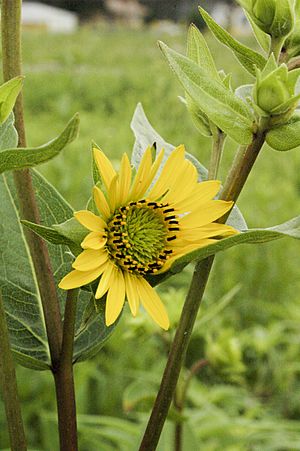Silphium integrifolium facts for kids
Quick facts for kids Silphium integrifolium |
|
|---|---|
 |
|
| Conservation status | |
| Scientific classification | |
| Genus: |
Silphium
|
| Species: |
integrifolium
|
Silphium integrifolium, also known as rosinweed or prairie rosinweed, is a type of flowering plant. It belongs to the aster family, called Asteraceae. You can find this plant growing naturally in eastern North America. This includes Ontario in Canada and many parts of the eastern and central United States, reaching as far west as New Mexico.
What Does Rosinweed Look Like?
This plant is a perennial herb, which means it lives for many years and has soft stems. It grows from a system of many thin roots. Its stems can reach up to 2 meters (about 6.5 feet) tall. One plant can form a large clump with as many as 100 stems! The stems can be smooth, slightly rough, or sometimes feel waxy.
The leaves grow directly from the stem and are arranged opposite each other. The leaves at the bottom of the plant usually fall off as the plant gets older. The leaf blades are shaped like a spear or an egg. Their edges can be smooth or have small teeth. They can be smooth or a bit rough, and grow up to about 23 centimeters (9 inches) long.
The plant produces 1 to 15 flower heads. Each head is surrounded by 2 or 3 rows of special leaves called phyllaries. These can be smooth or rough, and sometimes have tiny glands. They have rounded bases and pointed tips. Each flower head has up to 36 yellow ray florets (which look like petals) and many small yellow disc florets in the center. The fruit of the plant has a short, small tuft of hairs called a pappus.
There are two main types, or varieties, of Silphium integrifolium:
- S. integifolium var. integrifolium – This type usually grows from 40 to 200 centimeters (about 1.3 to 6.5 feet) tall.
- S. integifolium var. laeve – This type is generally 100 to 150 centimeters (about 3.3 to 5 feet) tall. It tends to have more florets and its leaves are smooth.
Rosinweed and Its Environment
The leaves of the rosinweed plant are a food source for plant-eating animals, also known as herbivores. For example, white-tailed deer and a type of blister beetle called Epicauta fabricius enjoy eating its foliage.
Scientists have also noticed that about 17% of the plant's fruits are eaten by lepidopteran larvae, which are caterpillars. The most common insect that feeds on this plant is the gall wasp called Antistrophus silphii. This wasp lays its eggs in the growing tip of the plant. As the wasp larvae grow, a round lump, called a gall, forms in the plant's tip. This gall can be up to 4 centimeters (about 1.5 inches) wide. The gall stops that part of the plant from growing taller. Up to 30 larvae can spend the winter inside each gall. They then change into adult wasps and come out the following season.
How People Use Rosinweed
Native American groups used this plant for different purposes. For example, the Meskwaki people used the roots of the rosinweed to help treat pain from injuries.
Today, people also grow Silphium integrifolium in gardens. Compared to other plants in the Silphium family, it is shorter and less likely to fall over. It also grows from seed to flower faster. Even though it looks similar to sunflowers (Helianthus), it is easier to manage than most perennial sunflowers. This is because it spreads more slowly. It is also not known to produce chemicals that harm other plants around it.
Researchers at The Land Institute, along with other groups, have started a project to make this plant a useful crop. They are working to grow it for its oilseed, which can be used to make vegetable oil.


